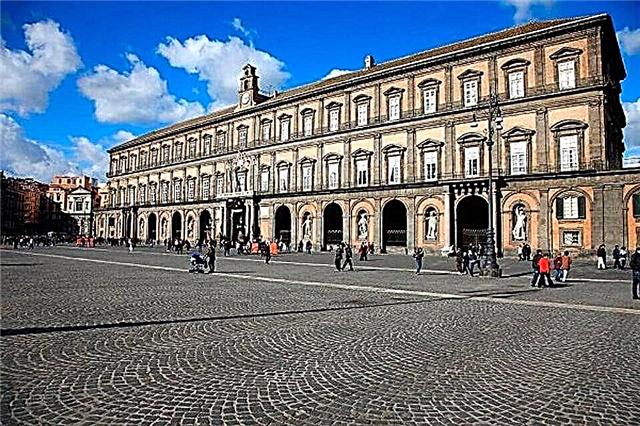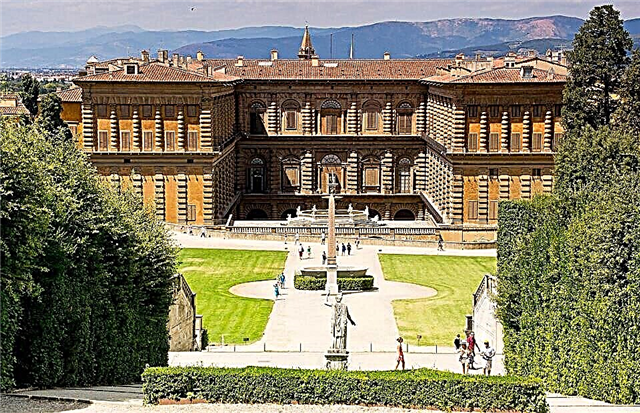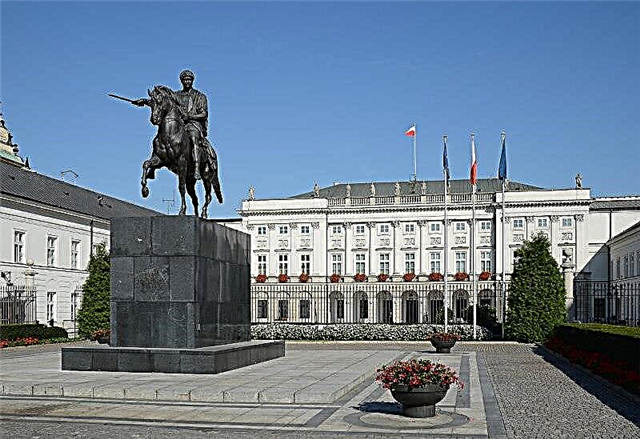Being the main and most famous landmark of the city, as well as the main historical, artistic and socio-political center, the Nizhny Novgorod Kremlin is the most grandiose and majestic of the medieval fortresses preserved in the central part of Russia. Currently, the complex is the only one among all the fortifications in the country included in the list of 14 wonders of Russia. Being one of the most perfect and unparalleled engineering and fortifications of the Middle Ages, the Kremlin in Nizhny Novgorod still amazes with its grandeur and external inaccessibility. The grandeur of the building is emphasized by the fact that the total length of the fortress wall exceeds two kilometers, and 13 towers strengthen it in various placesMoreover, all the towers of the Nizhny Novgorod Kremlin are unique: they have their own name, architectural features, purpose and centuries-old history.
George tower

According to the main version, the name of the St. George Tower was derived from the eponymous posad church of St. George the Victorious that existed nearby and has not survived to this day. The angular location of the tower, right on the edge of the slope that goes to the Volga, forced the construction of powerful buttresses in the process of its construction. In terms of the square Georgievskaya tower of the Nizhny Novgorod Kremlin, it was originally a travel card, while the passage inside the Kremlin was equipped at an angle to avoid a cross-fire from the cannons. As a result of adding soil in the 19th century, the currently visible height of the tower's façade decreased by several meters, and the gates themselves were practically filled up and today you can see only the upper part of their vault. The distinctive features of this four-tier tower of the Nizhny Novgorod Kremlin are narrow side loopholes, a scalloped fourth tier and a hipped roof.
Borisoglebskaya tower

Situated on a steep hillside, the Borisoglebskaya Tower, like the Georgievskaya Tower, owes its modern name to the Church of St. Boris and Gleb, which once functioned nearby. The second name - Dukhovskaya - the tower acquired in 1584, when a monastery of the same name was founded nearby, which existed within the walls of the Kremlin for 190 years.
Due to the constantly occurring landslides, which threatened the tower with collapse, it was rebuilt several times, and in 1785 it was completely dismantled. Only in 1966, as a result of excavations, fragments of the foundation of the Borisoglebsk tower were discovered, and 6 years later the four-tier round tower with 11 teeth on the upper tier was restored.
Conception tower

The completion in 2012 of work on the construction of the Conception Tower and the adjacent sections of the fortress wall marked the complete restoration of the complex, which, 125 years later, regained the form of a completely closed belt. Unlike most other towers of the Nizhny Novgorod Kremlin, Zachatyevskaya is only outwardly identical to its original appearance: the elements of the fortification are imitations, and the structure of the tower and the adjacent walls are hollow and built on a modern pile foundation. A distinctive feature of the Conception Tower is the use of not only brick, but also white limestone during the construction of the lower tier. Currently, the tower houses an exposition of the museum, including, among other things, fragments of an ancient tower found during excavations.
White Tower

White is the name of the round four-tier tower of the Nizhny Novgorod Kremlin, located in its sub-mountain (lower) part. A distinctive external feature of the tower is the well-preserved white stone facing of the lower tier facing the Volga. Belaya differs from other round towers of the Nizhny Novgorod Kremlin in the smaller thickness of the walls, which in turn made adjustments to the construction of floors and transitions between its individual tiers. The tower acquired its modern appearance, as close as possible to the original, after reconstruction in the 60s of the 20th century.
Ivanovskaya tower

One of the largest towers of the Nizhny Novgorod Kremlin and the main one in its foothill part. For the defense of the trading settlement of the city and the ships standing on the Volga roadstead, the Ivanovskaya tower was equipped with the most powerful weapons., which was periodically replaced by an even more modern one. The tower has a square shape in plan and differs from the other four square towers of the Nizhny Novgorod Kremlin by its higher base height and its increased area. The most noticeable external difference of the tower is the stepped construction, in which the area of the uppermost tier under the roof is less than the area of the previous tiers. Currently, the tower houses a museum exposition.
Clock tower

The only one of all the corner towers of the Nizhny Novgorod Kremlin, built with a ledge inward, which automatically transferred it to the category of not too important buildings in the defensive sense, without which the fortress could well do. Therefore, the tower initially served rather as the main guard post, because it is located at the very top of the Kremlin hill, from where a magnificent view opens.
And thanks to the "clock hut" - an additional wooden superstructure with a clock installed on the tower in the 16th century, the Clock Tower of the Nizhny Novgorod Kremlin has performed and continues to perform to this day an aesthetic function. The clock installed on the tower has long been the main city clock.
North tower

The northern tower of the fortress, located in the northwestern corner of its upland part and facing the Volga slope, is one of the well-preserved round towers of the Nizhny Novgorod Kremlin... Originally called Ilyinskaya (due to its location close to the Church of Elijah the Prophet), structurally, the North Tower differs little from the neighboring round towers of the Nizhny Novgorod Kremlin: four tiers, a small number of battle windows, square battlements in the upper part. Two entrances are equipped to the central rooms of the North Tower, and in order to enter its lower tier, you must use a special passage in the thickness of the wall next to the tower.
Taynitskaya tower

Another round tower of the Nizhny Novgorod Kremlin, towering over the steep slope of the Pochainsky ravine. The tower was called Taynitskaya because of the secret underground passage built next to it under the fortress walls to the Pochaina river, which once flowed along the bottom of the ravine and allowed the enemy to replenish the supply of drinking water imperceptibly from the enemy besieging the Kremlin.
For a long time, the Taynitskaya Tower served as a storage place for gunpowder used to protect the fortress, which was produced in a nearby ravine. Having a similar design to the other round towers of the Nizhny Novgorod Kremlin, Taynitskaya is equipped with large loopholes, which testifies to the former installation of more powerful weapons in it, which allows them to fire at the enemy at long distances.
Koromyslov tower

The corner round tower of the Nizhny Novgorod Kremlin, erected in the chain of the upland section of the fortress walls, at the junction of the Pochaina river with an artificial defensive ditch. According to two different legends, the tower owes its name to a young girl with a yoke buried under its foundation. According to another version, the tower, together with the longest spans (fortress walls) in the entire Kremlin, resembles a rocker from afar. The main difference between the tower and others is the use of white limestone for the construction and arrangement of the interior. Among all the other round towers of the Nizhny Novgorod Kremlin, it is Koromyslov, which is crowned with a green hipped roof, that has been best preserved to this day in its original form.
Nikolskaya tower

Passage tower, square in plan, named after the nearby church of St.Nicholas the Wonderworker, differs from others in the presence of an additional turret on the roof - a watchtower, due to which the total height of this tower of the Nizhny Novgorod Kremlin is about 30 meters. Once upon a time, it was possible to get into the fortress through the Nikolskaya tower only with the help of a suspension bridge lowered on chains across the fortress moat. In the 80s. of the last century, a pedestrian bridge was built across the Zelensky Congress, which leads directly to the passage gate partially laid at the beginning of the 18th century. Initially, the lower tier of the Nikolskaya Tower was made of white stone, but during the reconstruction in the middle of the 20th century, the stone that had lost its strength was replaced by red brick masonry.
Pantry tower

It was from the Pantry Tower that the construction of the Kremlin began more than 500 years ago in the form in which the fortress can be seen today... A wide round tower of the Nizhny Novgorod Kremlin, currently facing the city square of Minin and Pozharsky. The tower got its current name due to the fact that for a long time its lower tiers were used as a storage place for weapons and ammunition for them, oil for street lighting poles and other things useful in the urban economy. The tower seems smaller than it really is, because almost all of its lower tier is now located underground. However, the presence of battle chambers with embrasures in its walls indicates that the soil level was much lower during construction. The main difference between the upper part of the Pantry Tower and other round towers of the Nizhny Novgorod Kremlin is the absence of teeth on the fourth tier of the facade facing the courtyard and the transitions between individual tiers built in the thickness of the flat back wall.
Dmitrievskaya tower
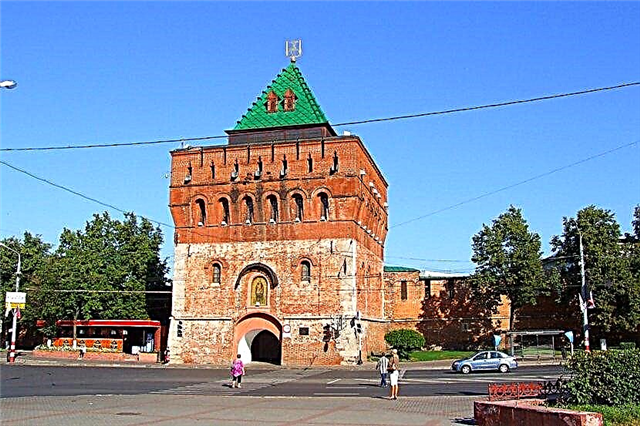
Due to its location in the center of the upland section of the Nizhny Novgorod Kremlin, the square Dmitrievskaya Tower occupies a dominant position in it. The facade of this powerful tower, together with the roof, is 33 meters high. From the very end of construction, the gates of the Dmitrievskaya tower served as the main entrance to the fortress, and the numerous weapons installed in it surpassed the weapons of other towers in power and made Dmitrievskaya the main center of defense for the entire upper part of the Kremlin. According to various sources, the main tower originally had from 4 to 6 tiers, but due to a major reconstruction at the end of the 19th century, the tower did not retain its original appearance. And now Dmitrievskaya stands out among the other towers of the Nizhny Novgorod Kremlin by a number of distinctive features: inclined loopholes, an extended superstructure in the upper part, the presence of a "overhead light" equipped in the upper tier, necessary for high-quality illumination of the museum exhibits located inside the tower. Since 1965, the emblem of Nizhny Novgorod has been installed on the spire of the tower - a gilded walking deer.
Powder tower
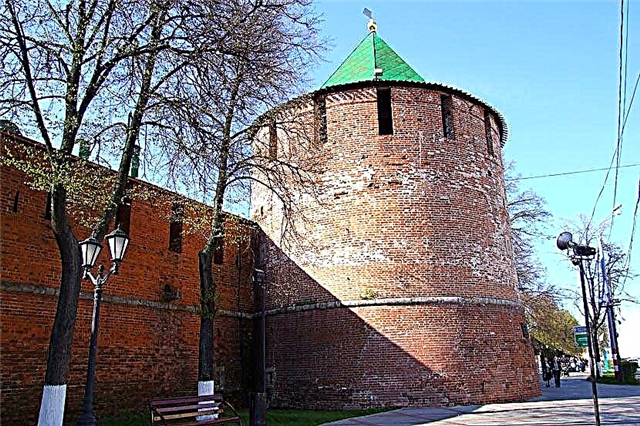
Received its modern name due to the use of black powder and other ammunition as the main storage site for the defense of the upland part of the Kremlin, the Powder Tower now stands out among the other round towers of the Nizhny Novgorod Kremlin with its squat silhouette. For a long time it was believed that there were only three tiers in the tower, and only in the middle of the 20th century, during excavations, a well-preserved lower tier was discovered, now completely hidden below the soil level. The main external feature of the tower is the absence of frontal loopholes, which testifies to the use of the tower during sieges solely to protect the adjoining spans with neighboring towers.
The carefully thought-out location of the fortress walls in relation to the terrain and the defensive power possessed by the towers of the Nizhny Novgorod Kremlin contributed to the fact that none of the many-day sieges of the fortress in the 16th century by enemy troops did not lead to the capture of the Kremlin, and after the fall of the Kazan Khanate, which had previously posed a threat, the medieval the fortification has lost its original military significance. At the present time, after a restoration that took several decades, the towers of the Nizhny Novgorod Kremlin and the spans connecting them are a real adornment of the city and allow one to see firsthand the talent and skill of medieval architects and architects.


